Man-In-The-Middle Attacks in Vehicular Ad-Hoc Networks: Evaluating the Impact of Attackers’ Strategies
Abstract
1. Introduction
1.1. Motivation
1.2. Research Question
1.3. Contributions
- We identified various flavors of MITM attackers in VANET with different capabilities such as message tampering, message delaying and message dropping.
- We established different strategies of the MITM attacker based on the mobility and distribution of the malicious nodes in VANET, and
- We developed a simulation-based model to evaluate the impact of various MITM attacks under different attacker patterns.
2. Related Work
2.1. Man-In-The-Middle Attacks for Wired and Wireless Networks
2.2. Man-In-The-Middle Attacks for VANET
3. Man-In-The-Middle Attacks
- Passive Mode: Passively, attacker can eavesdrop on the communication channel between legitimate vehicles, e.g., police vehicles or ambulances.
- Active Mode: Actively, attacker can drop, delay or change the content of received information in the network.
- Delay the legitimate message
- Drop the legitimate message
- Tamper the legitimate message
3.1. MITM as Message Delayed
3.2. MITM as Message Dropped
3.3. MITM as Message Tampered
- “data” into misleading “compromised data”
- “transmission time” into compromised transmission time by changing it with garbage time
- coordinates of sender location into unknown location
- First, the attackers are distributed randomly across the network
- Second, the attackers exist in fleet structure where the attacks are launched in a collaborative manner.
4. Simulation Environment
4.1. Simulation Setup
- Scenario 1: Attackers are distributed randomly across the network, and
- Scenario 2: Attackers are present together in a fleet structure.
4.2. Simulation Scenario Setup
4.3. Performance Evaluation Metrics
- End-to-End Delay: This metric is related to QoS of the network, indicating the delay caused to packet generated by legitimate node to be shared with neighbouring nodes. E2ED is the difference of packet generation time and packet reception time which is calculated as follows:
- Content Delivery Ratio (CDR): Content delivery ratio shows the amount of messages which are received successfully by the legitimate vehicles [45]. Let are the number of received messages and are the number of messages which are expected to be received within the network, then CDR is given as:Let ‘N’ is the total number of vehicles which are transmitting ‘’ messages, then is calculated as:
- Packet Loss Ratio (PLR): Packet loss ratio shows the amount of the messages which are lost due to MITM nodes. Let are the total number of messages, out of which messages are lost, then PLR is given as:includes messages which are received at both legitimate and malicious nodes. Let is the number of received messages at legitimate nodes and is the amount of messages lost at the MITM nodes, then is given as:
- Number of Compromised Messages: This metric indicates the number of messages compromised (either tampered or delayed) from the malicious node.
- Number of Dropped Messages: This metric is defined for MITM which is dropping the messages received from legitimate nodes. This metric shows the amount of messages dropped by the attackers in the network.
5. Results and Discussion
5.1. Simulation Results
5.1.1. Message Delay Attacks
5.1.2. Message Drop Attacks
5.1.3. Message Tamper Attacks
5.2. Discussion
6. Conclusions
Author Contributions
Conflicts of Interest
Abbreviations
| AODV | Ad Hoc On-Demand Distance Vector |
| AOMDV | Ad Hoc On-Demand Multipath Distance Vector |
| CDR | Content Delivery Ratio |
| DoS | Denial-of-service |
| DSR | Dynamic Source Routing |
| DSDV | Destination-Sequenced Distance-Vector |
| E2E | End-to-end |
| GSM | Global System for Mobile communications |
| HTTPS | Hypertext Transfer Protocol Secure |
| ITS | Intelligent Transportation System |
| IoT | Internet of Things |
| LTE | Long Term Evolution |
| MANET | Mobile Ad-hoc Networks |
| MITM | Man-In-The-Middle |
| MAC | Medium Access Control |
| OLSR | Optimized Link State Routing |
| OSI | Open Systems Interconnection |
| PLR | Packet Loss Ratio |
| RSU | Roadside Unit |
| SSL | Secure-Socket Layer |
| UMTS | Universal Mobile Telecommunications System |
| VANET | Vehicular Ad-Hoc Networks |
| WHO | World Health Organization |
| ZRP | Zone Routing Protocol |
References
- Yaqoob, I.; Hashem, I.A.T.; Mehmood, Y.; Gani, A.; Mokhtar, S.; Guizani, S. Enabling Communication Technologies for Smart Cities. IEEE Commun. Mag. 2017, 55, 112–120. [Google Scholar] [CrossRef]
- Chen, S.; Xu, H.; Liu, D.; Hu, B.; Wang, H. A Vision of IoT: Applications, Challenges, and Opportunities With China Perspective. IEEE Internet Things J. 2014, 1, 349–359. [Google Scholar] [CrossRef]
- Mehmood, Y.; Ahmad, F.; Yaqoob, I.; Adnane, A.; Imran, M.; Guizani, S. Internet-of-Things Based Smart Cities: Recent Advances and Challenges. IEEE Commun. Mag. 2017, 55, 16–24. [Google Scholar] [CrossRef]
- Zhong, H.; Huang, B.; Cui, J.; Xu, Y.; Liu, L. Conditional Privacy-Preserving Authentication Using Registration List in Vehicular Ad Hoc Networks. IEEE Access 2018, 6, 2241–2250. [Google Scholar] [CrossRef]
- Sun, Y.; Wu, L.; Wu, S.; Li, S.; Zhang, T.; Zhang, L.; Xu, J.; Xiong, Y. Security and Privacy in the Internet of Vehicles. In Proceedings of the International Conference on Identification, Information, and Knowledge in the Internet of Things (IIKI), Beijing, China, 22–23 October 2015; pp. 116–121. [Google Scholar] [CrossRef]
- Lu, Z.; Qu, G.; Liu, Z. A Survey on Recent Advances in Vehicular Network Security, Trust, and Privacy. IEEE Trans. Intell. Transp. Syst. 2018, 1–17. [Google Scholar] [CrossRef]
- Cui, J.; Xu, W.; Zhong, H.; Zhang, J.; Xu, Y.; Liu, L. Privacy-Preserving Authentication Using a Double Pseudonym for Internet of Vehicles. Sensors 2018, 18, 1453. [Google Scholar] [CrossRef] [PubMed]
- Al-kahtani, M. Survey on Security Attacks in Vehicular Ad hoc Networks (VANETs). In Proceedings of the 6th International Conference on Signal Processing and Communication Systems (ICSPCS), Gold Coast, Australia, 12–14 December 2012; pp. 1–9. [Google Scholar]
- Ahmad, F.; Hall, J.; Adnane, A.; Franqueira, V.N.L. Faith in Vehicles: A Set of Evaluation Criteria for Trust Management in Vehicular Ad-Hoc Network. In Proceedings of the IEEE International Conference on Internet of Things (iThings) and IEEE Green Computing and Communications (GreenCom) and IEEE Cyber, Physical and Social Computing (CPSCom) and IEEE Smart Data (SmartData), Exeter, UK, 21–23 June 2017; pp. 44–52. [Google Scholar] [CrossRef]
- Ahmad, F.; Adnane, A. A Novel Context-based Risk Assessment Approach in Vehicular Networks. In Proceedings of the IEEE 30th International Conference on Advanced Information Networking and Applications Workshops, Crans-Montana, Switzerland, 23–25 March 2016. [Google Scholar]
- Stricot-Tarboton, S.; Chaisiri, S.; Ko, R.K.L. Taxonomy of Man-in-the-Middle Attacks on HTTPS. In Proceedings of the 2016 IEEE Trustcom/BigDataSE/ISPA, Tianjin, China, 23–26 August 2016; pp. 527–534. [Google Scholar] [CrossRef]
- Chen, Z.; Guo, S.; Duan, R.; Wang, S. Security Analysis on Mutual Authentication against Man-in-the-Middle Attack. In Proceedings of the First International Conference on Information Science and Engineering, Nanjing, China, 26–28 December 2009; pp. 1855–1858. [Google Scholar] [CrossRef]
- Conti, M.; Dragoni, N.; Lesyk, V. A Survey of Man In The Middle Attacks. IEEE Commun. Surv. Tutor. 2016, 18, 2027–2051. [Google Scholar] [CrossRef]
- Glass, S.M.; Muthukkumarasamy, V.; Portmann, M. Detecting Man-in-the-Middle and Wormhole Attacks in Wireless Mesh Networks. In Proceedings of the International Conference on Advanced Information Networking and Applications, Bradford, UK, 26–29 May 2009; pp. 530–538. [Google Scholar]
- Kaplanis, C. Detection and Prevention of Man in the Middle Attacks in Wi-Fi Technology. Master’s Thesis, Aalborg University, Aalborg, Denmark, 2015. [Google Scholar]
- Raya, M.; Papadimitratos, P.; Hubaux, J.P. Securing Vehicular Communications. IEEE Wirel. Commun. Mag. 2006, 13, 8–15. [Google Scholar] [CrossRef]
- de Fuentes, J.M.; Gonzalez-Tablas, A.I.; Ribagorda, A. Overview of Security Issues in Vehicular Ad-Hoc Networks. In Handbook of Research on Mobility and Computing, Evolving Technologies and Ubiquitous Impact; Cruz-Cunha, M.M., Moreira, F., Eds.; IGI Global: New York, NY, USA, 2010; pp. 894–911. [Google Scholar]
- Sumra, I.A.; Hasbullah, H.; Lail, J.; Rehman, M. Trust and Trusted Computing in VANET. Comput. Sci. J. 2011, 1, 29–51. [Google Scholar]
- Papadimitratos, P.; Buttyan, L.; Holczer, T.; Schoch, E.; Freudiger, J.; Raya, M.; Ma, Z.; Kargl, F.; Kung, A.; Hubaux, J.P. Secure Vehicular Communication Systems: Design and Architecture. IEEE Commun. Mag. 2008, 46, 100–109. [Google Scholar] [CrossRef]
- Sakiz, F.; Sen, S. A Survey of Attacks and Detection Mechanisms on Intelligent Transportation Systems: VANETs and IoV. Ad Hoc Netw. 2017, 61, 33–50. [Google Scholar] [CrossRef]
- Vinh, H.L.; Cavalli, A.R. Security Attacks and Solutions in Vehicular Ad Hoc Networks: A Survey. Int. J. AdHoc Netw. Syst. 2014, 4, 1–20. [Google Scholar] [CrossRef]
- Siddiqui, N.; Khaliq, K.A.; Pannek, J. VANET Security Analysis on the Basis of Attacks in Authentication. In Proceedings of the 5th International Conference on Dynamics in Logistics, Bremen, Germany, 22–25 February 2016; pp. 491–502. [Google Scholar]
- Ahmad, F.; Adnane, A.; Franqueira, V.N.L. A Systematic Approach for Cyber Security in Vehicular Networks. J. Comput. Commun. 2016, 4, 569–571. [Google Scholar] [CrossRef]
- Hamida, E.B.; Noura, H.; Znaidi, W. Security of Cooperative Intelligent Transport Systems: Standards, Threats Analysis and Cryptographic Countermeasures. Electronics 2015, 4, 380–423. [Google Scholar] [CrossRef]
- Afdhal, A.; Muchallil, S.; Walidainy, H.; Yuhardian, Q. Black Hole Attacks Analysis for AODV and AOMDV Routing Performance in VANETs. In Proceedings of the International Conference on Electrical Engineering and Informatics (ICELTICs), Banda Aceh, Indonesia, 18–20 October 2017; pp. 29–34. [Google Scholar] [CrossRef]
- Dhyani, I.; Goel, N.; Sharma, G.; Mallick, B. A Reliable Tactic for Detecting Black Hole Attack in Vehicular Ad Hoc Networks. In Advances in Computer and Computational Sciences; Springer: Berlin, Germany, 2017; pp. 333–343. [Google Scholar]
- Grimaldo, J.; Martí, R. Performance Comparison of Routing Protocols in VANETs under Black Hole Attack in Panama City. In Proceedings of the International Conference on Electronics, Communications and Computers (CONIELECOMP), Cholula, Mexico, 21–23 February 2018; pp. 126–132. [Google Scholar] [CrossRef]
- Purohit, K.C.; Dimri, S.C.; Jasola, S. Mitigation and Performance Analysis of Routing Protocols Under Black-Hole Attack in Vehicular Ad-Hoc Network (VANET). Wirel. Personal Commun. 2017, 97, 5099–5114. [Google Scholar] [CrossRef]
- Almutairi, H.; Chelloug, S.; Alqarni, H.; Aljaber, R.; Alshehri, A.; Alotaish, D. A New Black Hole Detection Scheme for VANETs. In Proceedings of the 6th International Conference on Management of Emergent Digital EcoSystems, Buraidah, Saudi Arabia, 15–17 September 2014; ACM: New York, NY, USA, 2014; pp. 133–138. [Google Scholar]
- Cherkaouia, B.; Beni-Hssanea, A.; Erritali, M. Quality Control Chart for Detecting the Black Hole Attack in Vehicular Ad-Hoc Networks. In Proceedings of the 8th International Conference on Emerging Ubiquitous Systems and Pervasive Networks (EUSPN 2017), Lund, Sweden, 18–20 September 2017; pp. 170–177. [Google Scholar]
- Rawat, D.B.; Bista, B.B.; Yan, G. Securing Vehicular Ad-Hoc Networks from Data Falsification Attacks. In Proceedings of the IEEE Region 10 Conference (TENCON), Singapore, 22–25 November 2016; pp. 99–102. [Google Scholar] [CrossRef]
- Leinmuller, T.; Schmidt, R.K.; Schoch, E.; Held, A.; Schafer, G. Modeling Roadside Attacker Behavior in VANETs. In Proceedings of the IEEE Globecom Workshops, New Orleans, LA, USA, 30 November–4 December 2008; pp. 1–10. [Google Scholar]
- Grover, J.; Laxmi, V.; Gaur, M.S. Attack Models and Infrastructure Supported Detection Mechanisms for Position Forging Attacks in Vehicular Ad Hoc Networks. CSI Trans. ICT 2013, 1, 261–279. [Google Scholar] [CrossRef]
- Nayak, G.N.; Samaddar, S.G. Different Flavours of Man-In-The-Middle Attack, Consequences and Feasible Solutions. In Proceedings of the 3rd International Conference on Computer Science and Information Technology, Chengdu, China, 9–11 July 2010; Volume 5, pp. 491–495. [Google Scholar] [CrossRef]
- Ahmad, F.; Franqueira, V.N.L.; Adnane, A. TEAM: A Trust Evaluation and Management Framework in Context-Enabled Vehicular Ad-Hoc Networks. IEEE Access 2018, 6, 28643–28660. [Google Scholar] [CrossRef]
- European Telecommunications Standards Institute. Intelligent Transport Systems (ITS); Vehicular Communications; Basic Set of Applications; Part 2: Specification of Cooperative Awareness Basic Service, ETSI TS 102 637-2; Technical Report; ETSI: Sophia Antipolis, France, 2011. [Google Scholar]
- Santa, J.; Pereñíguez, F.; Moragón, A.; Skarmeta, A.F. Vehicle-to-Infrastructure Messaging Proposal Based on CAM/DENM Specifications. In Proceedings of the IFIP Wireless Days (WD), Valencia, Spain, 13–15 November 2013; IEEE: Piscataway, NJ, USA, 2013; pp. 1–7. [Google Scholar]
- Tobin, J.; Thorpe, C.; Murphy, L. An Approach to Mitigate Black Hole Attacks on Vehicular Wireless Networks. In Proceedings of the IEEE 85th Vehicular Technology Conference (VTC Spring), Sydney, NSW, Australia, 4–7 June 2017; pp. 1–7. [Google Scholar] [CrossRef]
- VEINS. Vehicles in Network Simulation, The Open Source Vehicular Simulation Framework. Available online: http://veins.car2x.org (accessed on 5 July 2018).
- Sommer, C.; German, R.; Dressler, F. Bidirectionally Coupled Network and Road Traffic Simulation for Improved IVC Analysis. IEEE Trans. Mobile Comput. 2011, 10, 3–15. [Google Scholar] [CrossRef]
- SUMO. Simulation of Urban MObility. Available online: http://sumo.dlr.de/wiki/Simulation_of_Urban_MObility (accessed on 2 April 2018).
- OMNET. OMNET++: Discrete Event Simulator. Available online: https://omnetpp.org/ (accessed on 29 June 2018).
- Wegener, A.; Piórkowski, M.; Raya, M.; Hellbrück, H.; Fischer, S.; Hubaux, J.P. TraCI: An Interface for Coupling Road Traffic and Network Simulators. In Proceedings of the 11th Communications and Networking Simulation Symposium, Ottawa, ON, Canada, 13–16 April 2008; ACM: New York, NY, USA, 2008; pp. 155–163. [Google Scholar]
- Alishev, D.; Hussain, R.; Nawaz, W.; Lee, J. Social-Aware Bootstrapping and Trust Establishing Mechanism for Vehicular Social Networks. In Proceedings of the 85th Vehicular Technology Conference (VTC Spring), Sydney, NSW, Australia, 4–7 June 2017; pp. 1–5. [Google Scholar]
- Chaqfeh, M.; Lakas, A. A Novel Approach for Scalable Multi-hop Data Dissemination in Vehicular Ad Hoc Networks. Ad Hoc Netw. 2016, 37, 228–239. [Google Scholar] [CrossRef]

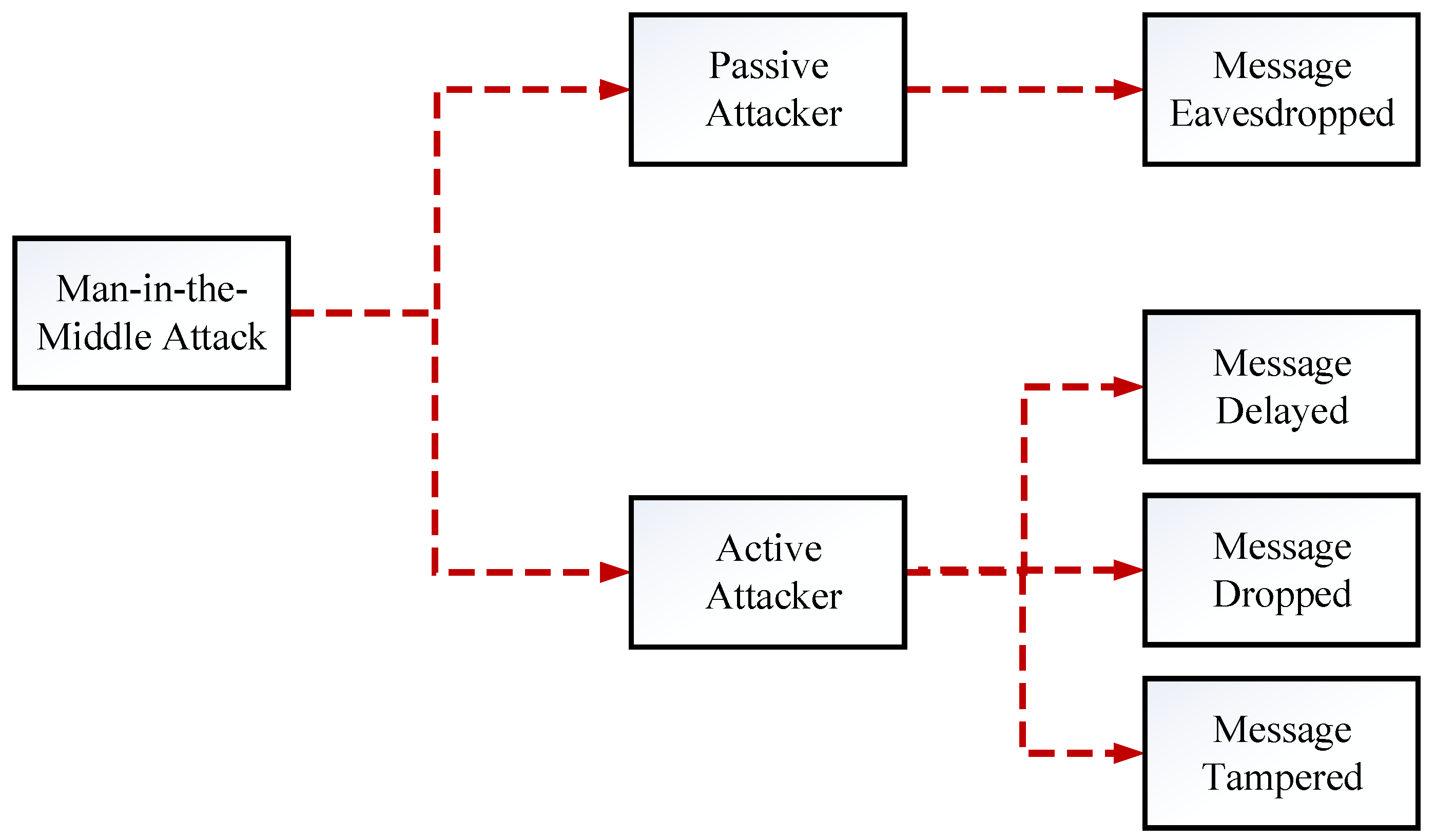
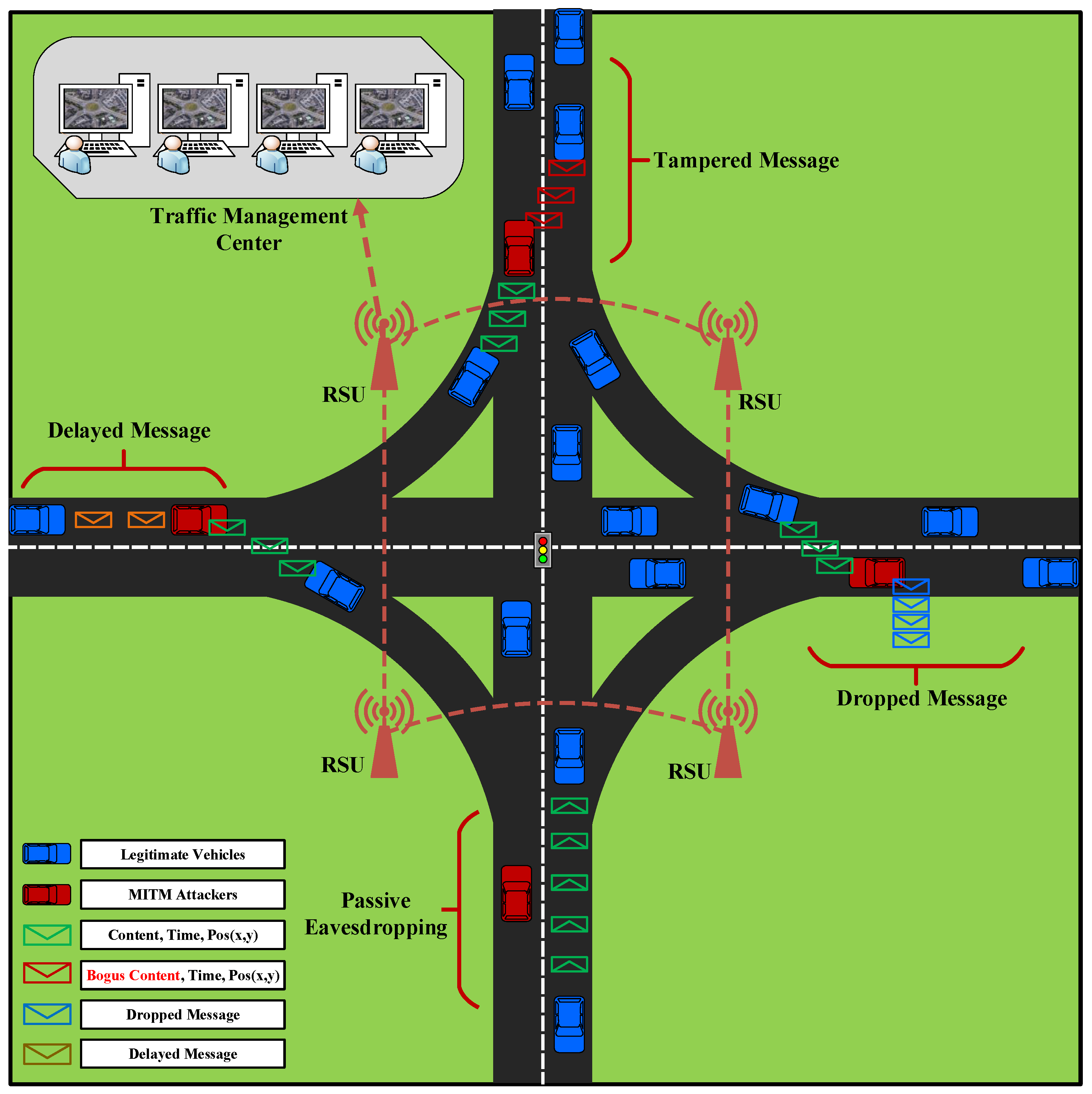
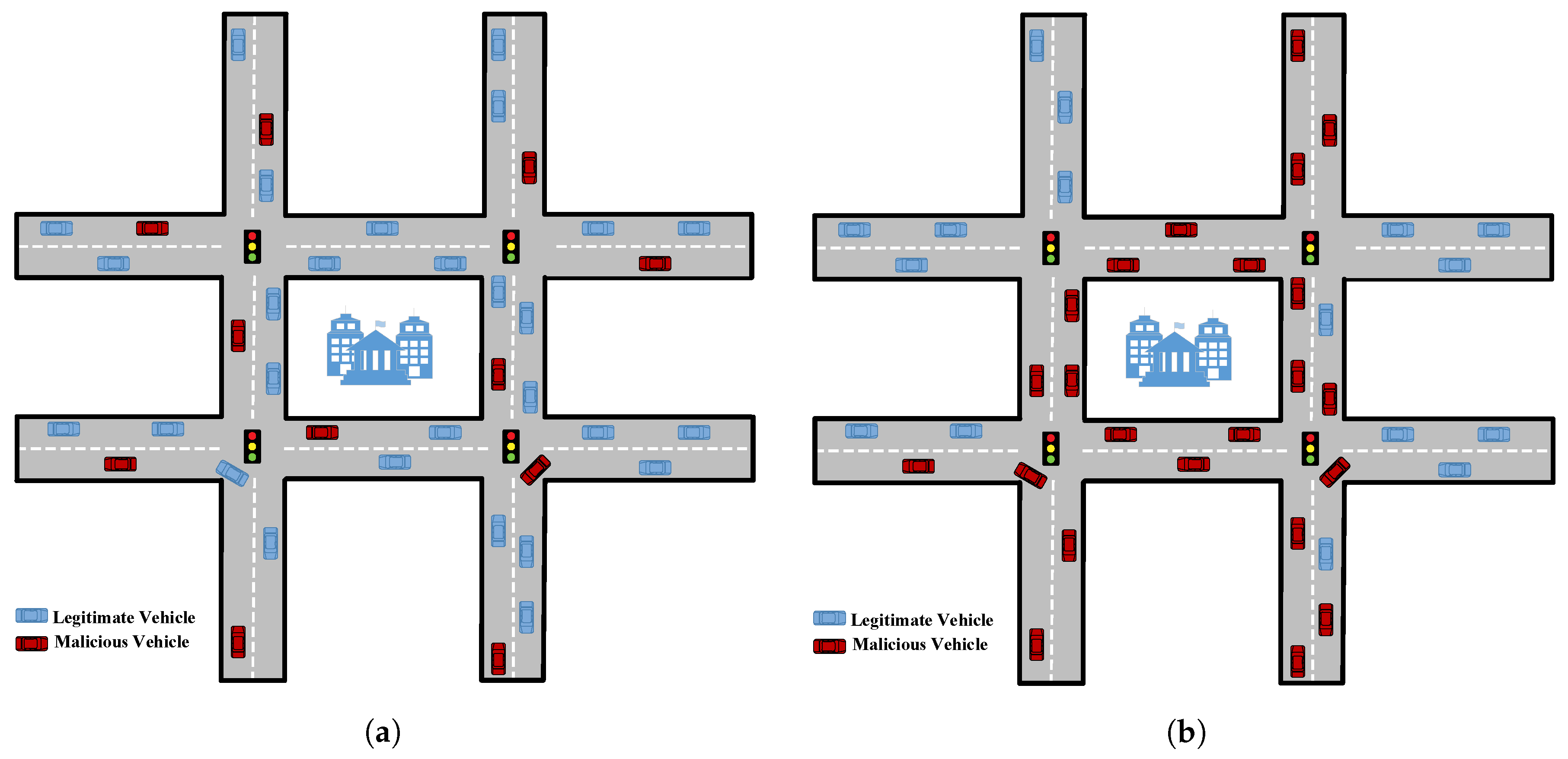
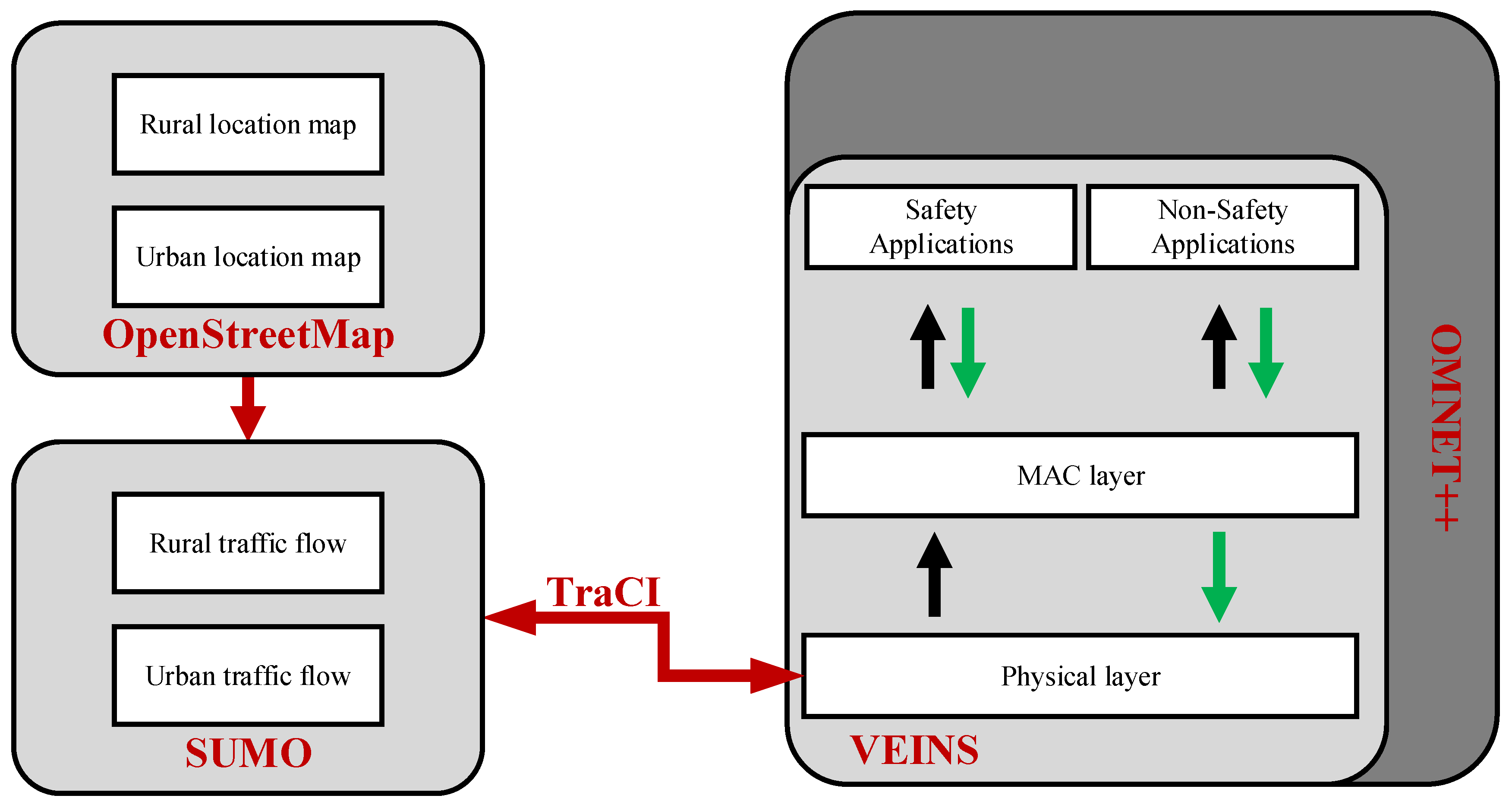
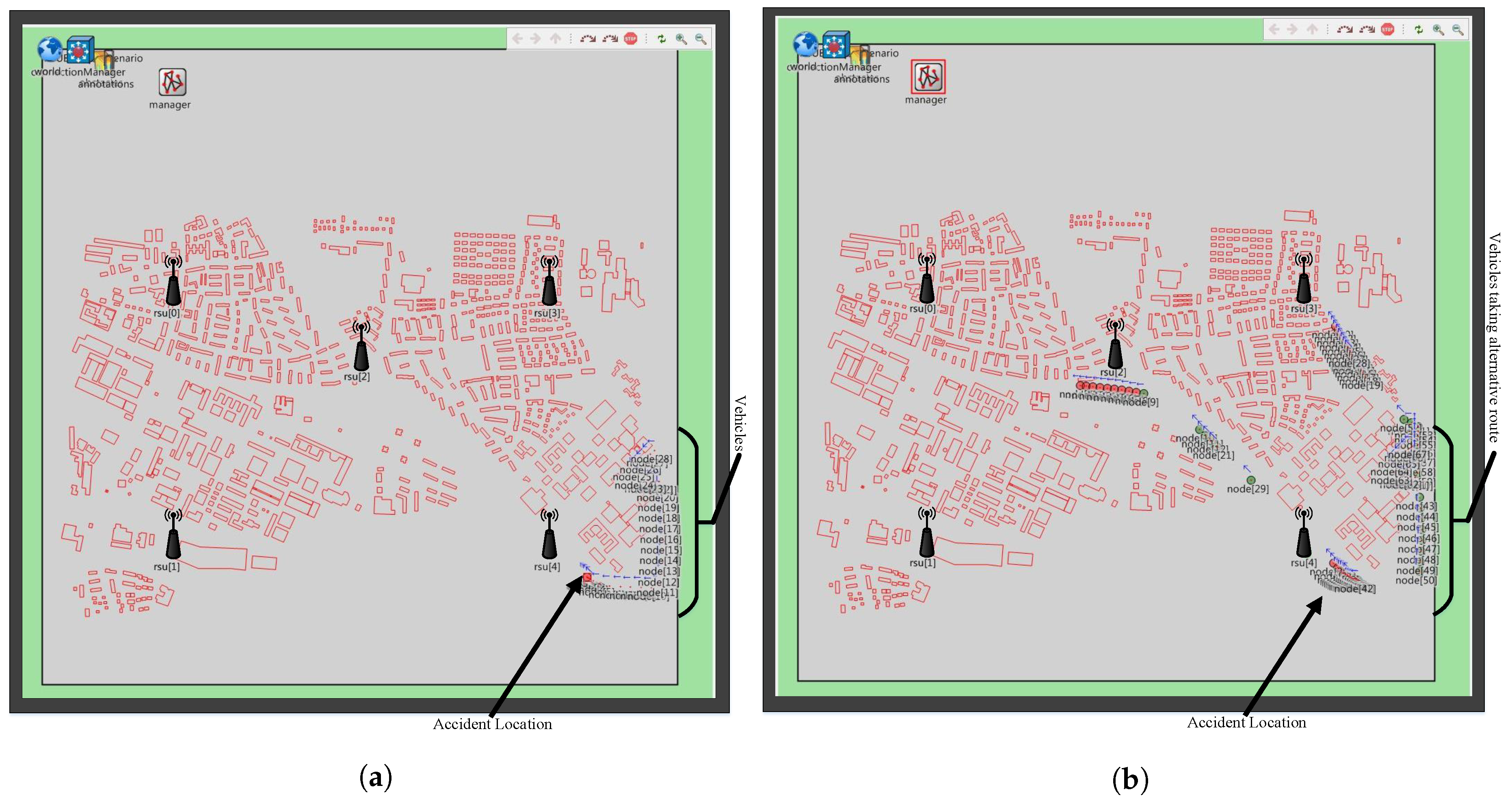
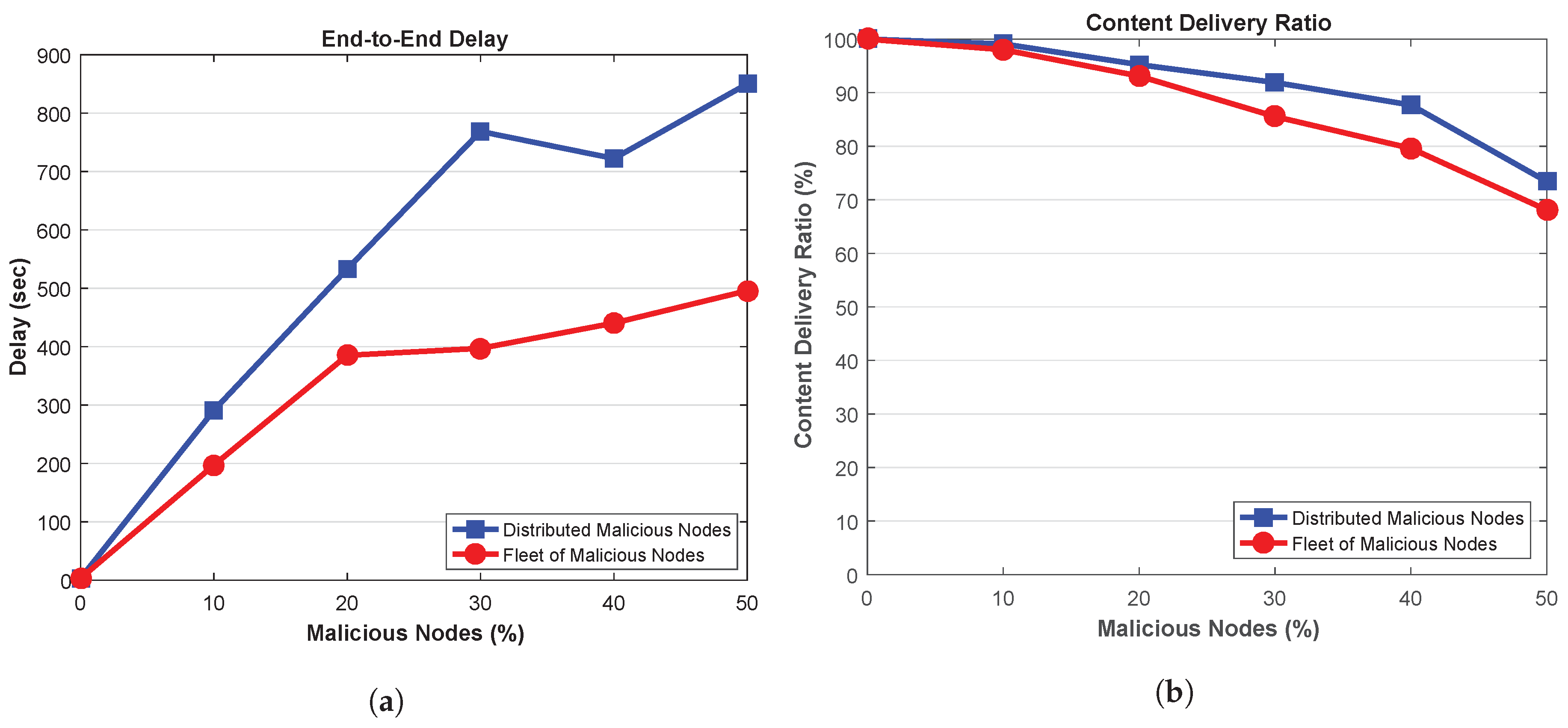
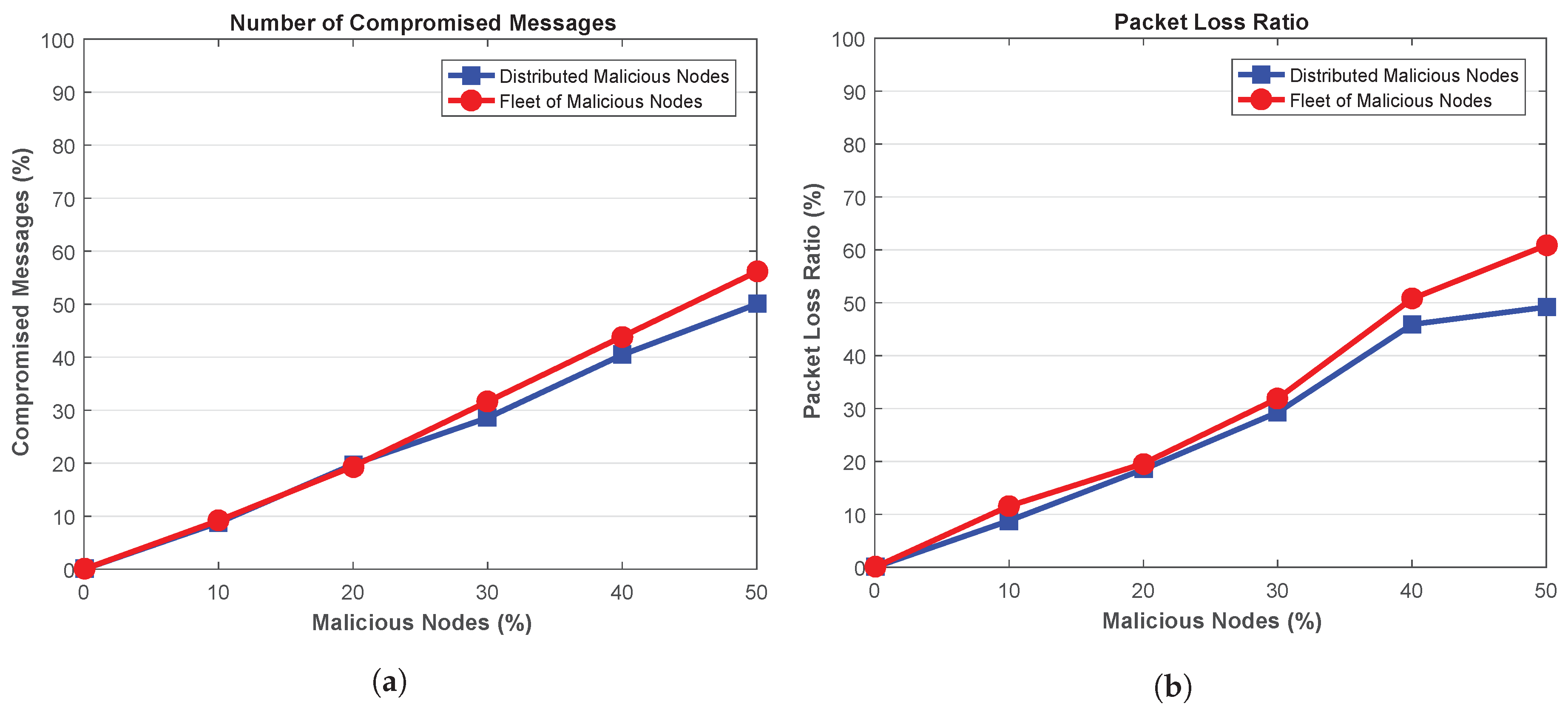
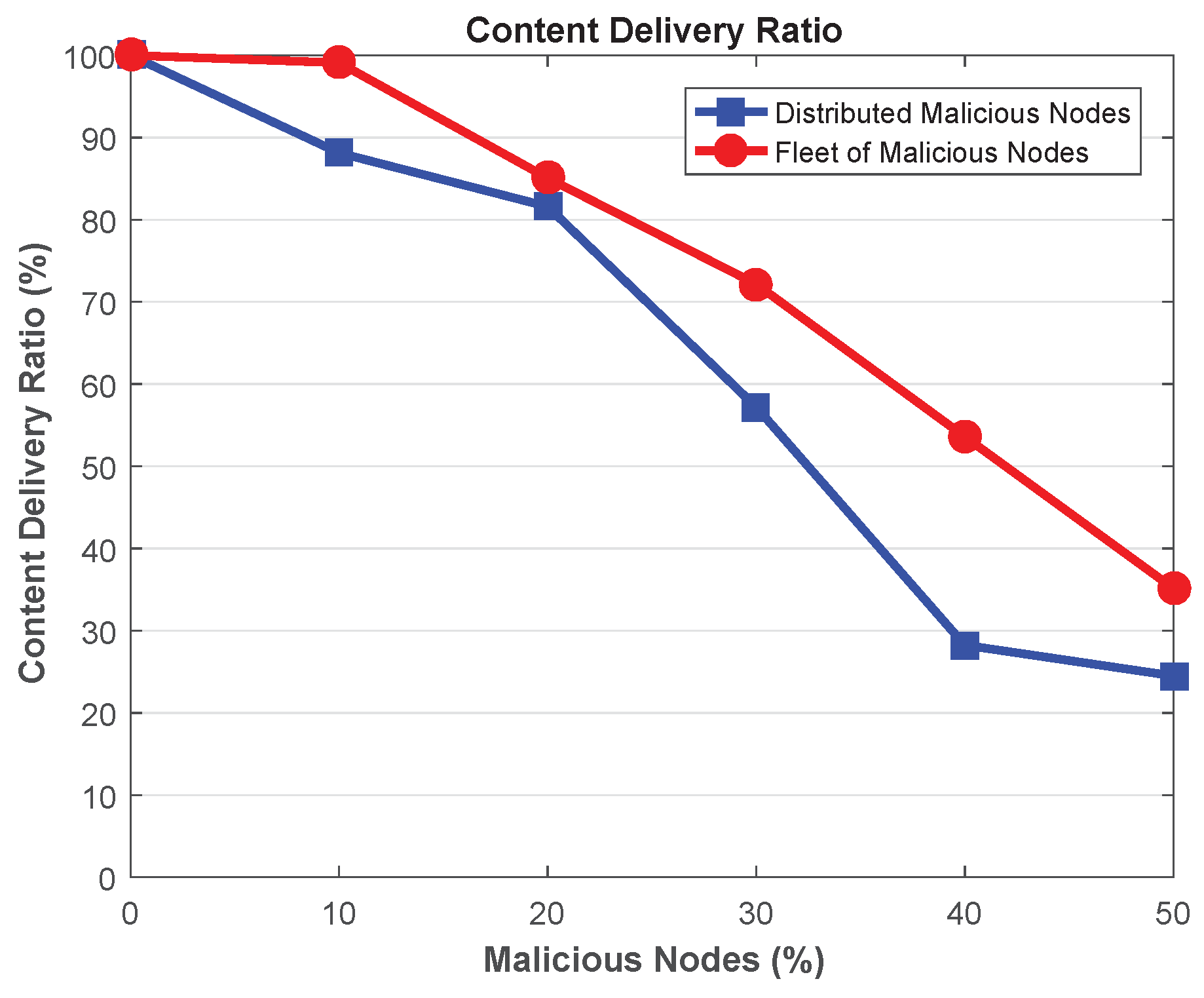
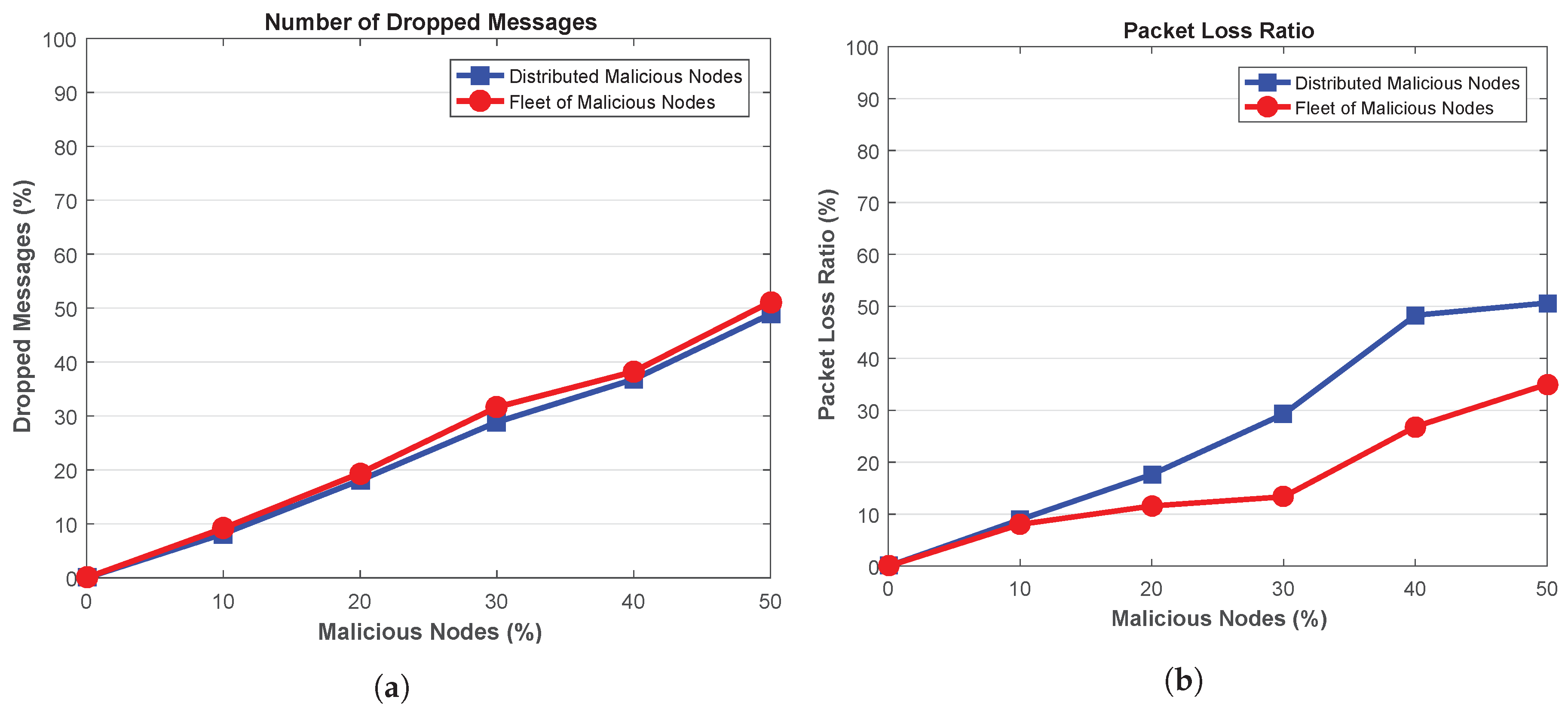
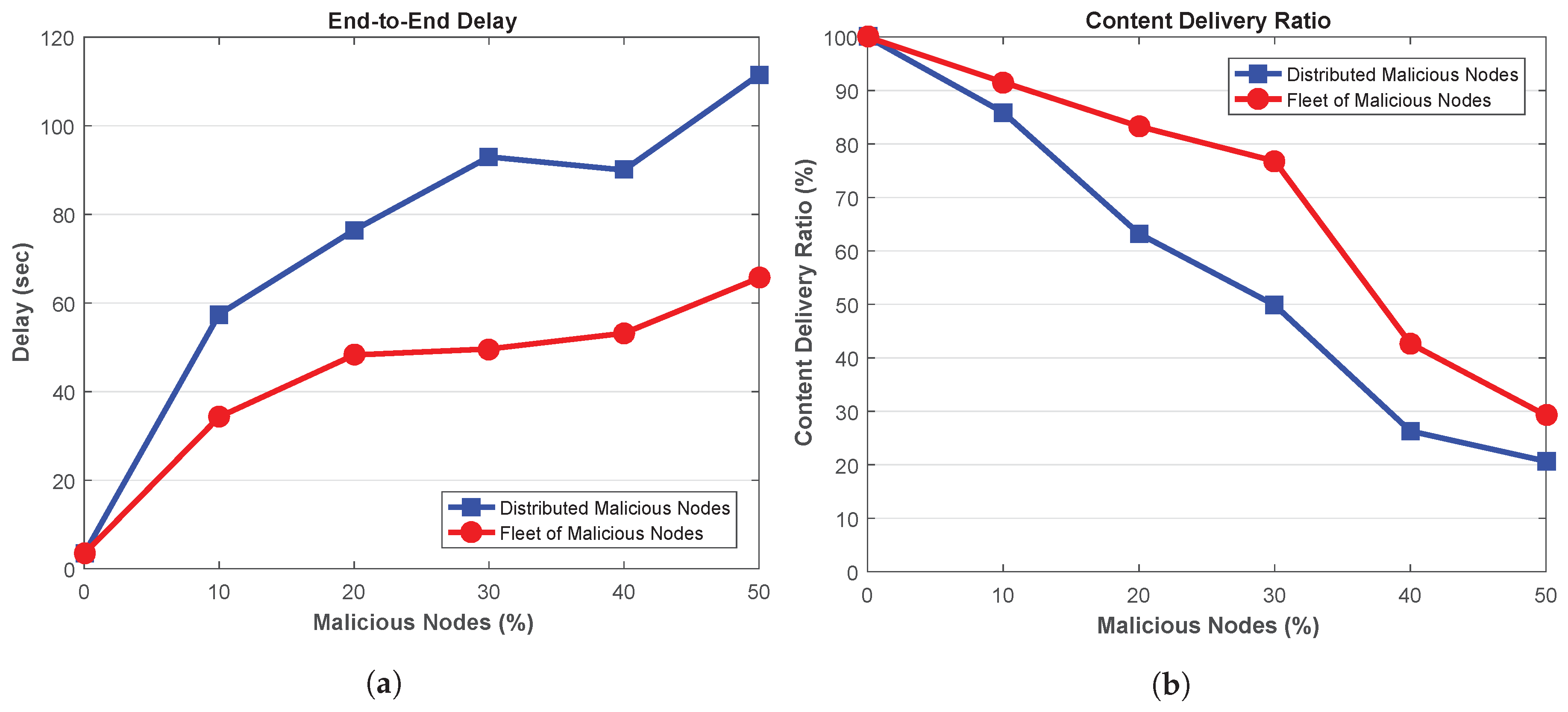
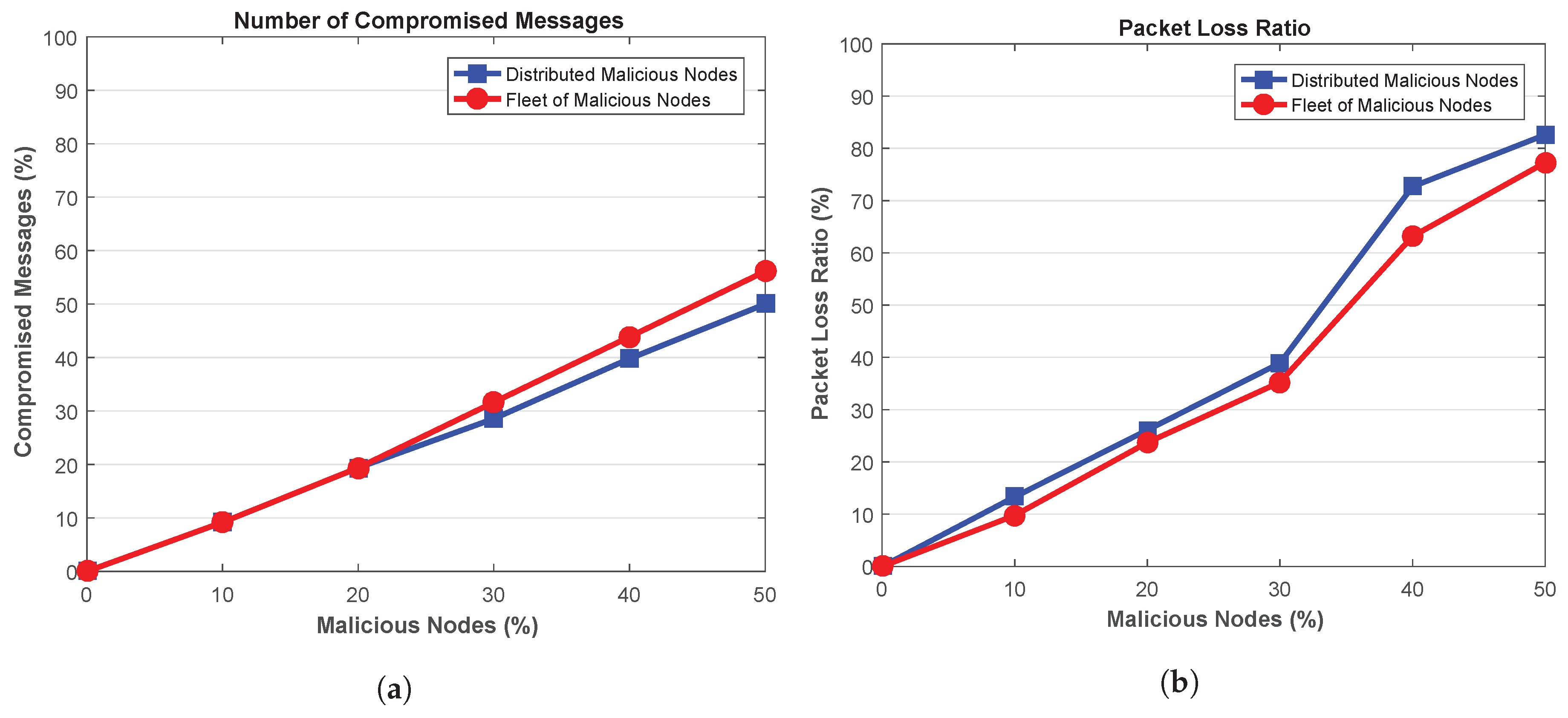
| Studies | Man-In-The-Middle Attacks | Attacker Pattern | |||
|---|---|---|---|---|---|
| Message Tampered | Message Delayed | Message Dropped | Distributed Attackers | Fleet of Attackers | |
| Afdhal et al. [25] | ✓ | ✓ | |||
| Dhyani et al. [26] | ✓ | ✓ | |||
| Grimaldo et al. [27] | ✓ | Unspecified | |||
| Purohit et al. [28] | ✓ | ✓ | |||
| Almutairi et al. [29] | ✓ | ✓ | |||
| Cherkaoui et al. [30] | ✓ | ✓ | |||
| Rawat et al. [31] | ✓ | ✓ | |||
| Leinmuller et al. [32] | ✓ | Unspecified | |||
| Grover et al. [33] | ✓ | Unspecified | |||
| Proposed Study | ✓ | ✓ | ✓ | ✓ | ✓ |
| Parameter | Value | |
|---|---|---|
| Simulation Framework | Network Simulator | OMNET++ 5.0 |
| Traffic Simulator | SUMO 0.25.0 | |
| V2X Simulator | VEINS 4.4 | |
| Simulation Details | No. of Vehicles | 100 |
| No. of RSUs | 5 | |
| No. of Malicious Nodes | 10%, 20%, 30%, 40%, 50% | |
| Simulation Area | 2.5 km × 2.5 km | |
| Simulation Time | 1000 s | |
| Accident Start time | 75 s | |
| Accident Duration | 50 s | |
| Communication Range | 250 m | |
| Vehicle Maximum Speed | 13.9 km/h | |
| Protocols | MAC Protocol | IEEE 802.11p |
| Network Protocol | IEEE 1609.4 (WAVE) | |
| Radio Propagation Model | Simple Path Loss | |
| Data Size | 1024 bits | |
| Header Size | 256 bits | |
© 2018 by the authors. Licensee MDPI, Basel, Switzerland. This article is an open access article distributed under the terms and conditions of the Creative Commons Attribution (CC BY) license (http://creativecommons.org/licenses/by/4.0/).
Share and Cite
Ahmad, F.; Adnane, A.; Franqueira, V.N.L.; Kurugollu, F.; Liu, L. Man-In-The-Middle Attacks in Vehicular Ad-Hoc Networks: Evaluating the Impact of Attackers’ Strategies. Sensors 2018, 18, 4040. https://doi.org/10.3390/s18114040
Ahmad F, Adnane A, Franqueira VNL, Kurugollu F, Liu L. Man-In-The-Middle Attacks in Vehicular Ad-Hoc Networks: Evaluating the Impact of Attackers’ Strategies. Sensors. 2018; 18(11):4040. https://doi.org/10.3390/s18114040
Chicago/Turabian StyleAhmad, Farhan, Asma Adnane, Virginia N. L. Franqueira, Fatih Kurugollu, and Lu Liu. 2018. "Man-In-The-Middle Attacks in Vehicular Ad-Hoc Networks: Evaluating the Impact of Attackers’ Strategies" Sensors 18, no. 11: 4040. https://doi.org/10.3390/s18114040
APA StyleAhmad, F., Adnane, A., Franqueira, V. N. L., Kurugollu, F., & Liu, L. (2018). Man-In-The-Middle Attacks in Vehicular Ad-Hoc Networks: Evaluating the Impact of Attackers’ Strategies. Sensors, 18(11), 4040. https://doi.org/10.3390/s18114040







